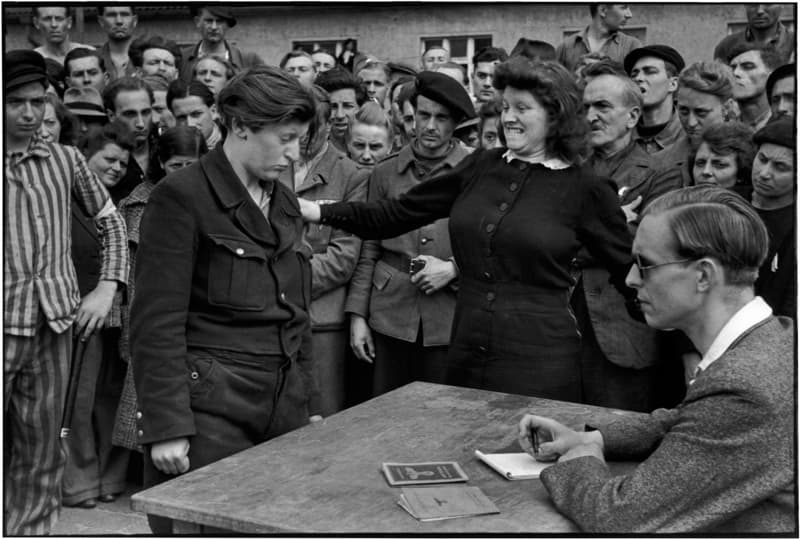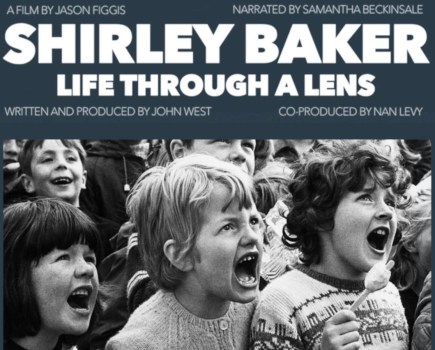Image: Dessau. A young Belgian woman and former Gestapo informer, being identified as she tried to hide in the crowd © Henri Cartier-Bresson/Magnum Photo
The ‘decisive moment’ is a phrase so frequently quoted when describing the work of Henri Cartier-Bresson that it has become almost a cliché. It was the title of the English edition of his landmark 1952 book, but its original French title, Images à la Sauvette, is roughly translated as images taken ‘on the run’. Nevertheless, it’s a phrase that gets directly to the heart of Cartier-Bresson’s photography and cannot be avoided when discussing this extraordinary picture, shot in Germany in April 1945.
Cartier-Bresson was 36 years old at the time the photo was taken and had been taking photographs since 1931. He had also worked in filmmaking and had assisted the celebrated French director Jean Renoir on two of his films.
At the outbreak of the Second World War in 1939, Cartier-Bresson joined the French Army’s film and photo unit. His work involved filming and photographing artillery fire, road bombardments and troop movements. However, in June 1940, he was taken prisoner by the German army and was held for more than three years, most of which were spent doing hard manual labour.
He tried to escape three times and succeeded at the third attempt, returning to France with forged papers. Before being captured, Cartier-Bresson had buried his beloved Leica in farmland in France. One of the first things he did after escaping was to return to the farm and dig it up. He later photographed the liberation of Paris in the summer of 1944 while working as a war correspondent.
The following year, the American Office of War Information asked Cartier-Bresson to make a documentary film about French prisoners of war and refugees; it was, as Cartier-Bresson called it, ‘a film by prisoners about prisoners’.
Part of the resulting film, Le Retour (The Return), was made in an American-controlled transit camp for refugees, former prisoners of war and other ‘displaced persons’ in Dessau, Germany. One sequence, shot in April 1945, shows the interrogation of a Gestapo informer in front of a crowd. While the cameraman filmed the unfolding events, Cartier-Bresson photographed still images of the scene with his Leica from a slightly lower viewpoint.
The three people in Cartier-Bresson’s photograph are a woman being publicly exposed as a Nazi collaborator; the woman accusing her, dressed in black; and a gaunt, serious-looking man who is seated at a desk and clearly an authority figure. The identities of the two women are not known, but Cartier-Bresson noted that the accused woman was Belgian and ‘a Gestapo informer [who was] recognised before she could hide in the crowd.’
The man has been identified as Wilhelm Heinrich van der Velden, a young Dutchman who had been appointed camp commandant at Dessau by the American military. Van der Velden had himself been recently liberated from the Westerbork concentration camp, which was set up by the Nazis in the Netherlands.
At the moment the picture was taken, the informer stands with her head bowed in shame while the woman accusing her bares her teeth and raises her arm, filled with rage and the desire for revenge. Their contrasting expressions symbolise the feelings of people on the winning and losing sides in a long and devastating war: the triumphant anger of people finally liberated from the tyranny of Nazi control and the humiliation of the German defeat.
The footage in Le Retour offers a fascinating glimpse at background events to this image. The film’s Dessau sequence begins with an overview of the courtyard scene and shows that hundreds of former prisoners and refugees were watching the informer’s denunciation. The film cuts to her being escorted to a desk, where the accuser berates her and at one point hits her in the face, knocking her out of the frame. As Cartier-Bresson noted, however, the action captured in his photograph has been edited out of the film.
After shooting the famous image, Cartier-Bresson went on to record what happened afterwards. Subsequent pictures in the sequence show the accuser following the increasingly beleaguered and shamefaced informer and striking her with a stick as the crowd looks on. These images give some indication of the informer’s fate, but it’s the first image that captures, in one fleeting moment, everything that needs to be said about the situation.
It’s a feat that Cartier-Bresson achieved countless times in his career, and his approach to photography has since inspired generations of photojournalists. He later summed up this distinctive and revolutionary approach to photography in the introduction to Images à la Sauvette.
In this text, Cartier-Bresson wrote that his aim was to ‘preserve life in the act of living’, and added: ‘Above all, I craved to seize the whole essence, in the confines of one single photograph, of some situation that was in the process of unrolling itself before my eyes.’ That’s exactly what he achieves in this image.
Events of 1945
- 22 January: Franklin D Roosevelt is inaugurated as US President for an unprecedented fourth term
- 27 January: Nazi death camps at Auschwitz and Birkenau are liberated by Soviet forces
- 4 February: The Yalta Conference begins, at which Roosevelt, Churchill and
- Stalin discuss the reorganisation of Europe after the war
- 13-15 February: The Royal Air Force bombs Dresden in Germany, unleashing a firestorm that kills tens of thousands of people
- 18 March: Berlin is bombed by 1,250 US bombers
- 12 April: Franklin D Roosevelt dies suddenly and is replaced by Harry S Truman
- 30 April: As the Red Army approaches Berlin, Adolf Hitler and his wife Eva Braun commit suicide
- 2 May: Berlin falls into Soviet hands and soldiers hoist the Soviet flag over the Reich Chancellery
- 8 May: The end of the Second World War in Europe is celebrated in V-E Day
- 1 July: The Allied occupation forces divide Germany
- 6 August: The United States drops an atomic bomb on Hiroshima, Japan. Three days later, another atomic bomb dropped on Nagasaki leads to the Japanese surrender on 10 August
- 2 September: Second World War officially ends as the Japanese surrender is accepted by Supreme Allied Commander General Douglas MacArthur
Books and websites
Books: One of the best recent studies of Cartier-Bresson’s work is Henri Cartier-Bresson: The Modern Century by Peter Galassi. Alternatively, a good pocket-sized introduction to the photographer’s work is available in Henri Cartier-Bresson by Clément Chéroux. Both books are published by Thames & Hudson.
Websites: Many more of Cartier-Bresson’s images, including those from Dessau, can be seen on www.magnumphotos.com. The short section of film made at the same time as Cartier-Bresson’s photograph and included in the film Le Retour (1945) can be found by searching for the film’s title on www.youtube.com







